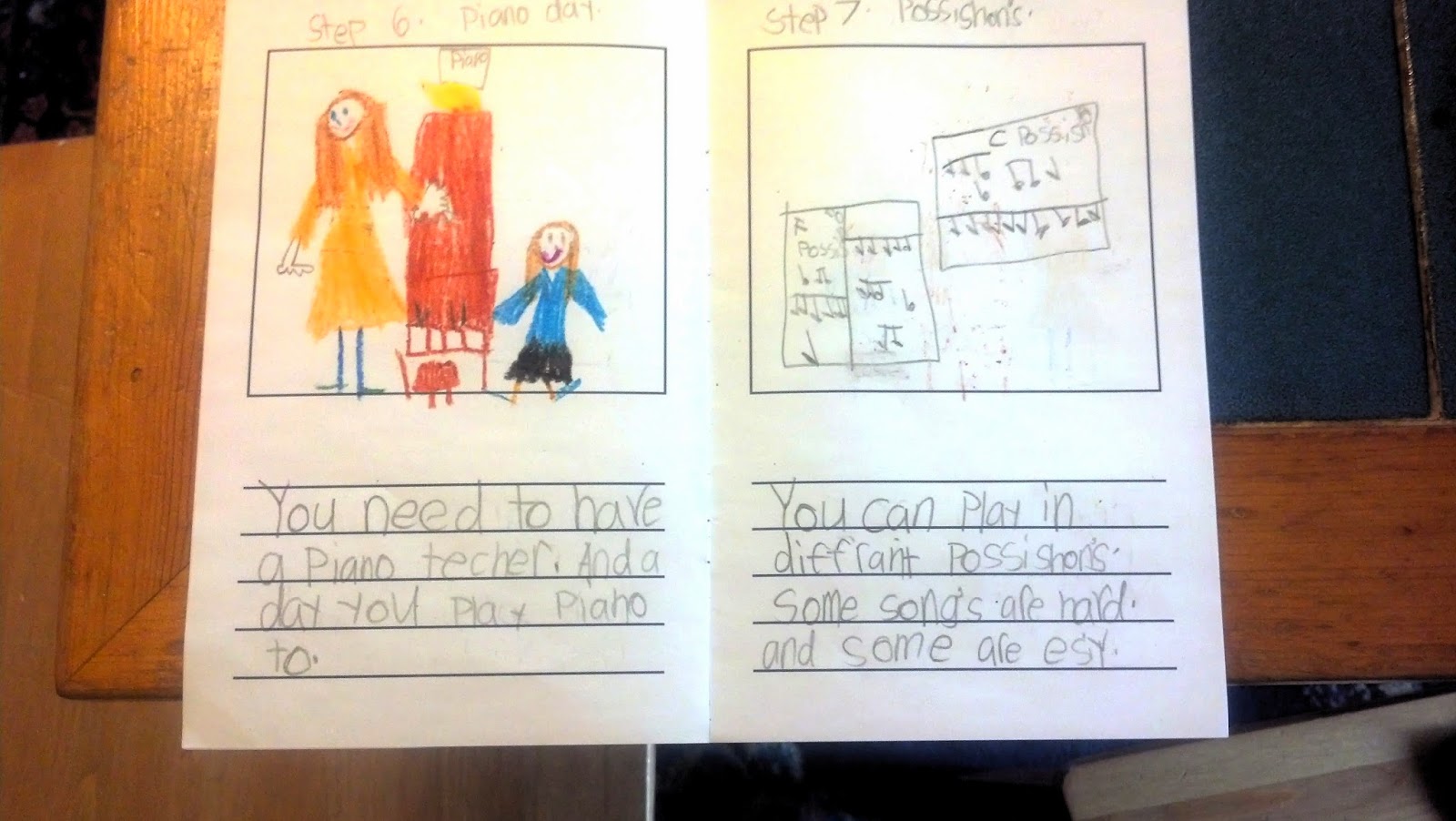As summer vacation draws close, Julia has been coming home with classroom projects from throughout the school year. Today I finally got to receive her "How To" book, in which she wrote about a topic of her expertise.
How to Play the Piano
by Julia Rowe
(I like that she included our flimsy halogen lamp, which we keep to the left of our piano just like in the illustration.)
Step 1: Note's
"I play the piano. Thar are sevan note's on the piano. They are ABCDEF and G."
There are actually 12 notes on the piano, if you include the sharps/flats, but I appreciate her attempt to not overwhelm the novice piano student by even getting into that. Let's just start with the white keys, of which there are indeed sevan.
Step 2: Sheet Music
"First you need a sheet of music. You need to have a piano to."
Sorry, all you would-be musicians who dreamed of playing air-piano. The expert has spoken. You need to have a piano to.
Step 3: Sharps
"You need to know were the note's are. You can tell were C is by two sharps."
I guess in Julia's version of the piano the sharps stick up like miniature little toothpicks - or bristles on a brush - from the GINORMOUS white keys. I think her version definitely makes it easier to find C. I mean, on a regular piano, there is certainly not just one honking humongous white key to every two or three black keys. You have to identify which one of the white keys amidst the two sharps is the note "C." Maybe future piano makers should adopt Julia's model, however, because it would make it a lot easier for beginning students to find the correct white key when there is really only ONE option.
Step 4: Were Note's Are
"But you don't need to know were just C is. You need to know were all the note's are."
Ah, good advice. After the previous page, I was thinking that all I had to do was find the two sharps and then I'd see my gargantuan-sized middle C. I guess it's more complicated than that.
Step 5: How Note's Go
"This is how note's go. A B C D E F G. A piano dos not have all the letter. But it has 7."
This is all true. It dos not have a letter H. Or any letters after H. Good point, Julia.
Step 6: Piano Day
"You need to have a piano techer. And a day you play piano to."
I would say you need more than a day to play piano. But I get it. You need one scheduled lesson day with your piano techer. Now, many piano students MIGHT feel that playing at the lesson counts enough for the week. But I might interject here that practicing IN BETWEEN lesson days is just as (if not MORE) important than playing on your lesson day.
Step 7: Possishon's
"You can play in diff'rant possishon's. Some song's are hard and some are esy."
I would say start with the esy song's first. The ones in the esy possishon's. Like C Possishon; remember, you can find C by finding the gigantic white key with two sharps sticking up from it!
Step 8: Resitall
"And then you can have a resitall. YOU ARE A GOOD PIANO PLAYER!"
I am?? Wow, this is easier than I thought! The subtitle of this book should be: "How to become a good piano player in eight simple steps." I guess my career is in trouble now, though. Who needs to hire a piano teacher if you can just read this book, follow the steps, and by the end YOU ARE A GOOD PIANO PLAYER!?
Of course, there is an About the Author on the back cover, so we get to learn a little more about Julia Rowe, Pianist:
About the Author
"My name is Julia. I love to play the piano. I hope this book will help you lern how to play piano. I also love to rite story's. I hope you like my book."
I do like it, Julia! Thanks for sharing your expertise! And as YOUR piano teacher, I have something to tell you: YOU ARE A GOOD PIANO PLAYER!







I followed this book and it's true! I AM NOW A GOOD PIANO PLAYER!
ReplyDeleteWow, I better get a copy so I can become a GOOD PIANO PLAYER too!
ReplyDelete